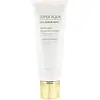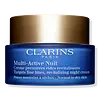What's inside
What's inside
 Key Ingredients
Key Ingredients

 Benefits
Benefits

 Concerns
Concerns

 Ingredients Side-by-side
Ingredients Side-by-side

Chamaecyparis Obtusa Water
MaskingSnail Secretion Filtrate
Skin ConditioningGlycerin
HumectantButylene Glycol
HumectantCaprylic/Capric Triglyceride
MaskingBehenyl Alcohol
EmollientAdansonia Digitata Seed Extract
Skin ConditioningCetearyl Alcohol
EmollientSucrose Polystearate
EmollientSodium Polyacrylate
AbsorbentCaprylyl Glycol
EmollientEthylhexylglycerin
Skin ConditioningSorbitol
HumectantHydrogenated Polyisobutene
EmollientParfum
MaskingHydroxypropyl Cyclodextrin
MaskingTocopheryl Acetate
AntioxidantDisodium EDTA
Centella Asiatica Meristem Cell Culture
AntioxidantXanthan Gum
EmulsifyingChamaecyparis Obtusa Water, Snail Secretion Filtrate, Glycerin, Butylene Glycol, Caprylic/Capric Triglyceride, Behenyl Alcohol, Adansonia Digitata Seed Extract, Cetearyl Alcohol, Sucrose Polystearate, Sodium Polyacrylate, Caprylyl Glycol, Ethylhexylglycerin, Sorbitol, Hydrogenated Polyisobutene, Parfum, Hydroxypropyl Cyclodextrin, Tocopheryl Acetate, Disodium EDTA, Centella Asiatica Meristem Cell Culture, Xanthan Gum
Water
Skin ConditioningCetearyl Isononanoate
EmollientGlycerin
HumectantIsononyl Isononanoate
EmollientPropanediol
SolventCetearyl Alcohol
EmollientSucrose Polystearate
EmollientButyrospermum Parkii Butter
Skin ConditioningCetearyl Glucoside
EmulsifyingSodium Stearoyl Glutamate
CleansingParfum
MaskingCellulose
AbsorbentCetyl Palmitate
EmollientDipsacus Sylvestris Extract
Skin ConditioningCaprylyl Glycol
EmollientCarbomer
Emulsion StabilisingEthylhexylglycerin
Skin ConditioningTocopheryl Acetate
AntioxidantDisodium EDTA
Sodium Hyaluronate
HumectantActinidia Chinensis Fruit Extract
EmollientButylene Glycol
HumectantMarrubium Vulgare Extract
Skin ConditioningHedychium Coronarium Root Extract
MaskingPhenethyl Alcohol
MaskingFurcellaria Lumbricalis Extract
Skin ConditioningSodium Citrate
BufferingCitric Acid
BufferingLactic Acid/Glycolic Acid Copolymer
Skin ConditioningLapsana Communis Flower/Leaf/Stem Extract
Skin ConditioningMaris Sal
Skin ConditioningHeptapeptide-15 Palmitate
Skin ConditioningPolyvinyl Alcohol
Copper Palmitoyl Heptapeptide-14
Skin ConditioningWater, Cetearyl Isononanoate, Glycerin, Isononyl Isononanoate, Propanediol, Cetearyl Alcohol, Sucrose Polystearate, Butyrospermum Parkii Butter, Cetearyl Glucoside, Sodium Stearoyl Glutamate, Parfum, Cellulose, Cetyl Palmitate, Dipsacus Sylvestris Extract, Caprylyl Glycol, Carbomer, Ethylhexylglycerin, Tocopheryl Acetate, Disodium EDTA, Sodium Hyaluronate, Actinidia Chinensis Fruit Extract, Butylene Glycol, Marrubium Vulgare Extract, Hedychium Coronarium Root Extract, Phenethyl Alcohol, Furcellaria Lumbricalis Extract, Sodium Citrate, Citric Acid, Lactic Acid/Glycolic Acid Copolymer, Lapsana Communis Flower/Leaf/Stem Extract, Maris Sal, Heptapeptide-15 Palmitate, Polyvinyl Alcohol, Copper Palmitoyl Heptapeptide-14
 Reviews
Reviews

Ingredients Explained
These ingredients are found in both products.
Ingredients higher up in an ingredient list are typically present in a larger amount.
Butylene Glycol (or BG) is used within cosmetic products for a few different reasons:
Overall, Butylene Glycol is a safe and well-rounded ingredient that works well with other ingredients.
Though this ingredient works well with most skin types, some people with sensitive skin may experience a reaction such as allergic rashes, closed comedones, or itchiness.
Learn more about Butylene GlycolCaprylyl Glycol is a humectant and emollient, meaning it attracts and preserves moisture.
It is a common ingredient in many products, especially those designed to hydrate skin. The primary benefits are retaining moisture, skin softening, and promoting a healthy skin barrier.
Though Caprylyl Glycol is an alcohol derived from fatty acids, it is not the kind that can dry out skin.
This ingredient is also used as a preservative to extend the life of products. It has slight antimicrobial properties.
Learn more about Caprylyl GlycolCetearyl alcohol is a mixture of two fatty alcohols: cetyl alcohol and stearyl alcohol. It is mainly used as an emulsifier. Emulsifiers help prevent the separation of oils and products. Due to its composition, it can also be used to thicken a product or help create foam.
Cetearyl alcohol is an emollient. Emollients help soothe and hydrate the skin by trapping moisture.
Studies show Cetearyl alcohol is non-toxic and non-irritating. The FDA allows products labeled "alcohol-free" to have fatty alcohols.
This ingredient is usually derived from plant oils such as palm, vegetable, or coconut oils. There is debate on whether this ingredient will cause acne.
Due to the fatty acid base, this ingredient may not be Malassezia folliculitis safe.
Learn more about Cetearyl AlcoholDisodium EDTA plays a role in making products more stable by aiding other preservatives.
It is a chelating agent, meaning it neutralizes metal ions that may be found in a product.
Disodium EDTA is a salt of edetic acid and is found to be safe in cosmetic ingredients.
Learn more about Disodium EDTAEthylhexylglycerin (we can't pronounce this either) is commonly used as a preservative and skin softener. It is derived from glyceryl.
You might see Ethylhexylglycerin often paired with other preservatives such as phenoxyethanol. Ethylhexylglycerin has been found to increase the effectiveness of these other preservatives.
Glycerin is already naturally found in your skin. It helps moisturize and protect your skin.
A study from 2016 found glycerin to be more effective as a humectant than AHAs and hyaluronic acid.
As a humectant, it helps the skin stay hydrated by pulling moisture to your skin. The low molecular weight of glycerin allows it to pull moisture into the deeper layers of your skin.
Hydrated skin improves your skin barrier; Your skin barrier helps protect against irritants and bacteria.
Glycerin has also been found to have antimicrobial and antiviral properties. Due to these properties, glycerin is often used in wound and burn treatments.
In cosmetics, glycerin is usually derived from plants such as soybean or palm. However, it can also be sourced from animals, such as tallow or animal fat.
This ingredient is organic, colorless, odorless, and non-toxic.
Glycerin is the name for this ingredient in American English. British English uses Glycerol/Glycerine.
Learn more about GlycerinParfum is a catch-all term for an ingredient or more that is used to give a scent to products.
Also called "fragrance", this ingredient can be a blend of hundreds of chemicals or plant oils. This means every product with "fragrance" or "parfum" in the ingredients list is a different mixture.
For instance, Habanolide is a proprietary trade name for a specific aroma chemical. When used as a fragrance ingredient in cosmetics, most aroma chemicals fall under the broad labeling category of “FRAGRANCE” or “PARFUM” according to EU and US regulations.
The term 'parfum' or 'fragrance' is not regulated in many countries. In many cases, it is up to the brand to define this term.
For instance, many brands choose to label themselves as "fragrance-free" because they are not using synthetic fragrances. However, their products may still contain ingredients such as essential oils that are considered a fragrance by INCI standards.
One example is Calendula flower extract. Calendula is an essential oil that still imparts a scent or 'fragrance'.
Depending on the blend, the ingredients in the mixture can cause allergies and sensitivities on the skin. Some ingredients that are known EU allergens include linalool and citronellol.
Parfum can also be used to mask or cover an unpleasant scent.
The bottom line is: not all fragrances/parfum/ingredients are created equally. If you are worried about fragrances, we recommend taking a closer look at an ingredient. And of course, we always recommend speaking with a professional.
Learn more about ParfumWe don't have a description for Sucrose Polystearate yet.
Tocopheryl Acetate is AKA Vitamin E. It is an antioxidant and protects your skin from free radicals. Free radicals damage the skin by breaking down collagen.
One study found using Tocopheryl Acetate with Vitamin C decreased the number of sunburned cells.
Tocopheryl Acetate is commonly found in both skincare and dietary supplements.
Learn more about Tocopheryl Acetate